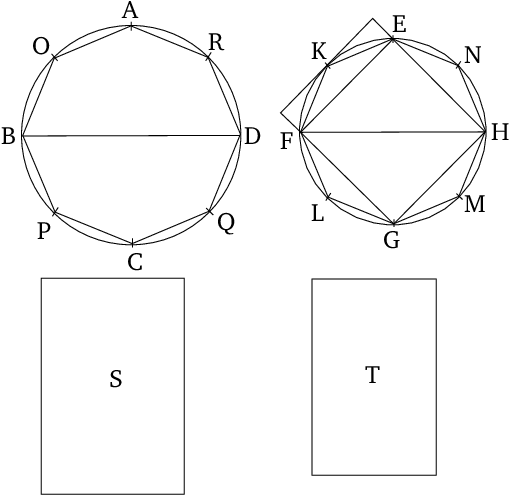Proof: By Euclid
(related to Proposition: Prop. 12.02: Areas of Circles are as Squares on Diameters)

- For if the circle $ABCD$ is not to the (circle) $EFGH$, as the square on $BD$ (is) to the (square) on $FH$, then as the (square) on $BD$ (is) to the (square) on $FH$, so circle $ABCD$ will be to some area either less than, or greater than, circle $EFGH$.
- Let it, first of all, be (in that ratio) to (some) lesser (area), $S$.
- And let the square $EFGH$ have been inscribed in circle $EFGH$ [Prop. 4.6].
- So the inscribed square is greater than half of circle $EFGH$, inasmuch as if we draw tangents to the circle through the points $E$, $F$, $G$, and $H$, then square $EFGH$ is half of the square circumscribed about the circle [Prop. 1.47], and the circle is less than the circumscribed square.
- Hence, the inscribed square $EFGH$ is greater than half of circle $EFGH$.
- Let the circumferences $EF$, $FG$, $GH$, and $HE$ have been cut in half at points $K$, $L$, $M$, and $N$ (respectively), and let $EK$, $KF$, $FL$, $LG$, $GM$, $MH$, $HN$, and $NE$ have been joined.
- And, thus, each of the triangles $EKF$, $FLG$, $GMH$, and $HNE$ is greater than half of the segment of the circle about it, inasmuch as if we draw tangents to the circle through points $K$, $L$, $M$, and $N$, and complete the parallelograms on the straight lines $EF$, $FG$, $GH$, and $HE$, then each of the triangles $EKF$, $FLG$, $GMH$, and $HNE$ will be half of the parallelogram about it, but the segment about it is less than the parallelogram.
- Hence, each of the triangles $EKF$, $FLG$, $GMH$, and $HNE$ is greater than half of the segment of the circle about it.
- So, by cutting the circumferences remaining behind in half, and joining straight lines, and doing this continually, we will (eventually) leave behind some segments of the circle whose (sum) will be less than the excess by which circle $EFGH$ exceeds the area $S$.
- For we showed in the first theorem of the tenth book that if two unequal magnitudes are laid out, and if (a part) greater than a half is subtracted from the greater, and (if from) the remainder (a part) greater than a half (is subtracted), and this happens continually, then some magnitude will (eventually) be left which will be less than the lesser laid out magnitude [Prop. 10.1].
- Therefore, let the (segments) have been left, and let the (sum of the) segments of the circle $EFGH$ on $EK$, $KF$, $FL$, $LG$, $GM$, $MH$, $HN$, and $NE$ be less than the excess by which circle $EFGH$ exceeds area $S$.
- Thus, the remaining polygon $EKFLGMHN$ is greater than area $S$.
- And let the polygon $AOBPCQDR$, similar to the polygon $EKFLGMHN$, have been inscribed in circle $ABCD$.
- Thus, as the square on $BD$ is to the square on $FH$, so polygon $AOBPCQDR$ (is) to polygon $EKFLGMHN$ [Prop. 12.1].
- But, also, as the square on $BD$ (is) to the square on $FH$, so circle $ABCD$ (is) to area $S$.
- And, thus, as circle $ABCD$ (is) to area $S$, so polygon $AOBPGQDR$ (is) to polygon $EKFLGMHN$ [Prop. 5.11].
- Thus, alternately, as circle $ABCD$ (is) to the polygon (inscribed) within it, so area $S$ (is) to polygon $EKFLGMHN$ [Prop. 5.16].
- And circle $ABCD$ (is) greater than the polygon (inscribed) within it.
- Thus, area $S$ is also greater than polygon $EKFLGMHN$.
- But, (it is) also less.
- The very thing is impossible.
- Thus, the square on $BD$ is not to the (square) on $FH$, as circle $ABCD$ (is) to some area less than circle $EFGH$.
- So, similarly, we can show that the (square) on $FH$ (is) not to the (square) on $BD$ as circle $EFGH$ (is) to some area less than circle $ABCD$ either.
- So, I say that neither (is) the (square) on $BD$ to the (square) on $FH$, as circle $ABCD$ (is) to some area greater than circle $EFGH$.
- For, if possible, let it be (in that ratio) to (some) greater (area), $S$.
- Thus, inversely, as the square on $FH$ [is] to the (square) on $DB$, so area $S$ (is) to circle $ABCD$ [Prop. 5.7 corr.] 1.
- But, as area $S$ (is) to circle $ABCD$, so circle $EFGH$ (is) to some area less than circle $ABCD$ (see lemma).
- And, thus, as the (square) on $FH$ (is) to the (square) on $BD$, so circle $EFGH$ (is) to some area less than circle $ABCD$ [Prop. 5.11].
- The very thing was shown (to be) impossible.
- Thus, as the square on $BD$ is to the (square) on $FH$, so circle $ABCD$ (is) not to some area greater than circle $EFGH$.
- And it was shown that neither (is it in that ratio) to (some) lesser (area).
- Thus, as the square on $BD$ is to the (square) on $FH$, so circle $ABCD$ (is) to circle $EFGH$.
- Thus, circles are to one another as the squares on (their) diameters.
- (Which is) the very thing it was required to show.
∎
Thank you to the contributors under CC BY-SA 4.0! 

- Github:
-

- non-Github:
- @Fitzpatrick
References
Adapted from (subject to copyright, with kind permission)
- Fitzpatrick, Richard: Euclid's "Elements of Geometry"
